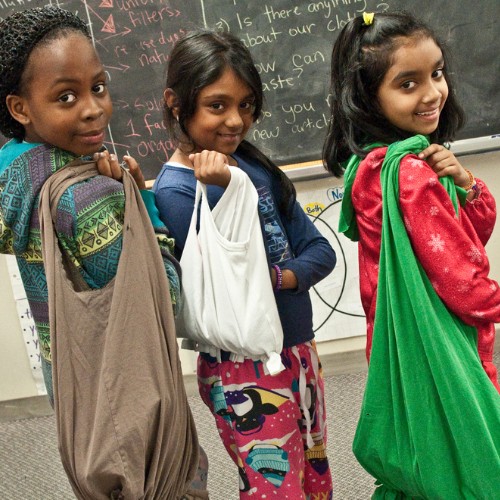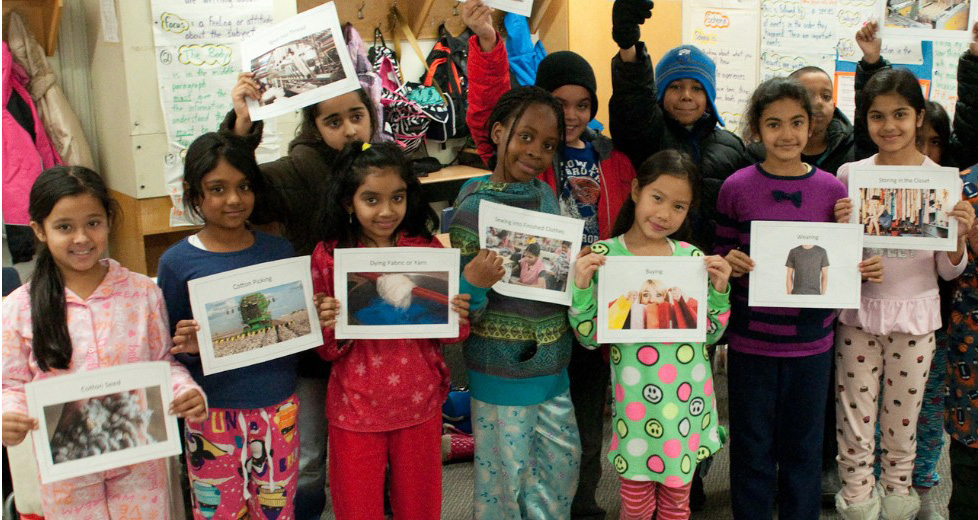 Responsible consumption and production
Responsible consumption and production
Teaching youth about the social and environmental impacts of clothing
Fashion shouldn’t cost lives or our planet, yet it does. It is one of the world’s top polluters via carbon emissions, waste, water pollution, and the use of toxic chemicals. The majority of the people who make our clothes are women and children, who work long hours for little pay in unsafe conditions. But the industry is not entirely to blame. We buy too many clothes and we treat them as disposable items. Fast fashion has made it easy and affordable for us to buy more clothes than ever before. For the most part, we are blind to the true cost of fashion, but that is largely due to a lack of awareness. And it is time for this to change. Young people are future consumers, and fashion and climate leaders. It is critical for them to know about the negative social and environmental impacts of clothing, before they develop “bad habits”. Once you know something, you can’t un-know it. Our workshops empower youth to become climate activists through a fun and relatable topic: fashion.
Necessity
Youth awareness about the negative social and environmental impacts of our clothes, both locally and globally.
Activity
Empower youth to become climate activists through a fun and relatable topic such as fashion.
Countable effort
Responsible purchasing and care for clothing, and increased diversion of textiles from landfills through reuse, repurpose and repair activities.
Result
Each donation will enable one student to understand the impact of their clothing purchases, becoming more responsible and conscious consumers.
Systemic effect
By increasing awareness and offering practical solutions, we will see consumer behaviour change that will benefit both people and planet.
Background
Globally, the fashion industry is responsible for 10% of all global greenhouse gas emissions (WEF, 2020). Producing synthetic fibres for textiles uses 342 million barrels of oil, and cotton production uses 200,000 tonnes of pesticides annually (Ellen MacArthur Foundation, 2017). The toxic waste water from clothing manufacturing is often dumped into the rivers in developing countries (River Blue, 2017). 92 million tonnes of clothing waste goes to landfill each year, and the equivalent of one garbage truck is landfilled every second of every day (BBC, 2020). Human rights violations are rampant, from unsafe working conditions to forced labour, and fashion is one of five key industries implicated in modern slavery (Global Slavery Index, 2018). The poorest people on the planet and their cheap labour are exploited to make our clothing. While the fashion industry is making progress to advance sustainability and reduce these impacts, we must do the same. We buy 60% more clothes today than 20 years ago, and we keep them for half as long (WRI, 2019). The average Canadian puts 81 lb of textiles in landfills each year, and many of these items could be reused or recycled (Recycling Council of Ontario, 2018). The amount of clothing we buy, how we care for our clothes, and what we do with them when we no longer want them, has a massive impact on people and planet. We need to change our behaviour, and it starts with our youth.
The good deed
Our education program empowers youth by raising awareness about the global negative social and environmental impacts of our clothing, and the solutions to help them be more responsible in their communities. This includes: • Buying less and investing in better quality, sustainably made garments • Washing our clothes in cold water to reduce energy consumption by 90% (EPA, 2014) • Air-drying clothes which can reduce the average household’s carbon footprint by 2,400 pounds a year (The Laundress, 2021) • Getting to stains right away so our clothes will stay in use for longer • Learning to repair a hole or sew on a button to prolong the life of a garment • Buying second hand and repurposing clothing to prevent it from ending up in the landfill • Donating our clothes to a thrift retailer or charity to divert them from the landfill and provide affordable clothing to those in need

About CANADA
The project will take place nationwide
25,000 retail and wholesale fashion companies in Canada
43.6 billion CA$ (domestic market value of the Canadian clothing and footwear industry)
World’s Gross Domestic Product of the fashion industry is 3 trillion dollars - 2% of the world’s GDP
The average Canadian buys 72 textile items/year, increasing demand on the supply chain and placing stress on raw materials, water, energy and waste to landfill.
About the organization and further information

Fashion Takes Action
Website
https://fashiontakesaction.com
Further information and source
- • Morgan McFall-Johnsen, 2020. These facts show how unsustainable the fashion industry is. World Economic Forum and Business Insider.
- • 2017, A new textiles economy: Redesigning fashion’s future, Ellen MacArthur Foundation
- • Mark Angelo, 2016. River Blue
- • Abigail Beall, 2020. Why clothes are so hard to recycle, BBC.
- • The Minderoo Foundation Pty Ltd., 2018. Global Slavery Index, Australia
- • Elizabeth Reichart and Deborah Drew, 2019. By the Numbers: The Economic, Social and Environmental Impacts of “Fast Fashion”, World Resources Institute
- • Waste Reduction Week, 2018. Recycling Council of Ontario
- • 2014, Environmental Protection Agency
- • 2021, 8 Reasons To Line Dry Your Clothes, The Laundress




